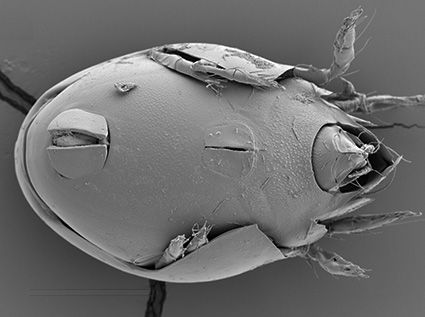Abstract
Based on materials from the leaf litter of a mixed forest in Crimea, a new diagnosis for the sexually dimorphic species, Chamobates callipygis Pavlichenko, 1991, is presented to accommodate its previously unreported females. This is the only species in Chamobatidae showing a distinct sexual dimorphism, which is expressed by the posterior porose region on the notogaster, such that males only have a large protuberance on the posterior part of notogaster bearing a pair of fused porose areas A3, and a densely striated region behind them. The specific function of this structure is not yet known, but the sexual dimorphism is presumably involved in pheromonal communication facilitating sperm transfer. Also, the males of this species have a few transverse striations in the dorsomedial part of notogaster (at level of porose areas A1 and A2). Further, we discuss all cases of sexual dimorphism in the superfamily Ceratozetoidea, and the possible function of this dimorphism.
References
Alberti, G. & Schuster, R. (2005) Behavioural and ultrastructural peculiarities of reproduction in Collohmannia gigantea (Oribatida: Mixonomata). In: Weigmann, G., Alberti, G., Wohltmann, A. & Ragusa, S. (Eds.), Acarine Biodiversity in the Natural and Human Sphere. Proceedings of the V Symposium of the European Association of Acarologists (Berlin 2004). Phytophaga, 14, pp. 129–140.
Bayartogtokh, B., Ermilov, S.G. & Corpuz-Raros, L. (2017) An interesting sexually dimorphic species, Neoribates isabelaensis sp. nov. (Acari, Oribatida, Parakalummidae) with remarks on sexual dimorphism in Oripodoidea. Zootaxa, 4347 (1), 94–108. https://doi.org/10.11646/zootaxa.4347.1.5
Behan-Pelletier, V.M. (1988) Redefinition of Zachvatkinibates (Acari: Mycobatidae), with description of a new species. The Canadian Entomologist, 120, 797–813. https://doi.org/10.4039/ent120797-8
Behan-Pelletier, V.M. (1996) Naiazetes reevesi n. g., n. sp., (Acari: Oribatida: Zetomimidae) from semi-aquatic habitats of eastern North America. Acarologia, 37 (4), 345–355. [http://www1.montpellier.inra.fr/CBGP/acarologia/article.php?id=4100]
Behan-Pelletier, V.M. (1998) Ceratozetoidea (Acari: Oribatida) of lowland tropical rainforest, La Selva, Costa Rica. Acarologia, 39 (4), 349–381. [https://www1.montpellier.inra.fr/CBGP/acarologia/article.php?id=190]
Behan-Pelletier, V.M. (2015) Review of sexual dimorphism in the brachypyline oribatid mites. Acarologia, 55 (2), 127–146. https://doi.org/10.1051/acarologia.20152163
Behan-Pelletier, V.M. & Eamer, B. (2003) Zetomimidae (Acari: Oribatida) of North America. In: Smith, I.M. (Ed.), An Acarological Tribute to David R. Cook. Indira Publishing House, West Bloomfield, Michigan, pp. 21–56.
Behan-Pelletier, V.M. & Eamer, B. (2005) Zachvatkinibates (Acari: Oribatida: Mycobatidae) of North America, with descriptions of sexually dimorphic species. The Canadian Entomologist, 137, 631–647. https://doi.org/10.4039/n05-055
Niemi, R. & Behan-Pelletier, V.M. (2004) Nuhivabates n. gen. and two new species, N. nukuhiva n. sp. and N. hivaoa n. sp. from Marquesas Islands (Acari: Oribatida: Mycobatidae). Acarologia, 44 (1–2), 73–85. [https://www1.montpellier.inra.fr/CBGP/acarologia/article.php?id=1869]
Norton, R.A. (1977) A review of F. Grandjean's system of leg chaetotaxy in the Oribatei (Acari) and its application to the family Damaeidae. In: Dindal, D.L. (Ed.), Biology of oribatid mites. SUNY College of Environmental Science and Forestry, Syracuse, pp. 33–61.
Norton, R.A. (1983) Redefinition of Mochloribatula (Acari, Mochlozetidae), with new species, recombinations, and notes on plant associations. Acarologia, 24 (4), 449–464. [https://www1.montpellier.inra.fr/CBGP/acarologia/export_pdf.php?id=2739&typefile=1]
Norton, R.A. & Alberti, G. (1997) Porose integumental organs of oribatid mites (Acari, Oribatida). 3. Evolutionary and ecological aspects. Zoologica, 146, 115–143.
Norton, R.A. & Behan-Pelletier, V.M. (2009) Chapter 15. Oribatida. In: Krantz, G.W. & Walter, D.E. (Eds.), A Manual of Acarology. Texas Tech University Press, Lubbock, Texas, pp. 430–564.
Norton, R.A. & Ermilov, S.G. (2014) Catalogue and historical overview of juvenile instars of oribatid mites (Acari: Oribatida). Zootaxa, 3833 (1), 1–132. https://doi.org/10.11646/zootaxa.3833.1.1
Norton, R.A. & Sidorchuk, E.A. (2014) Collohmannia johnstoni n. sp. (Acari, Oribatida) from West Virginia (U.S.A.) including description of ontogeny, setal variations, notes on biology and systematics of Collohmanniidae. Acarologia, 54 (1), 271–334. https://doi.org/10.1051/acarologia.20142134
Oliveira, A.R., Norton, R.A., de Moraes, G.J. & Faccini, J.L.H. (2007) Preliminary observations on courtship behaviour in Mochloribatula (Oribatida: Mochlozetidae). In: Morales-Malacara, J.B., Behan-Pelletier, V., Ueckermann, E., Pérez, T.M., Estrada-Venegas, E.G. & Badil, M. (Eds.), Acarology XI: Proceedings of the International Congress. Instituto de Biología and Facultad de Ciencias, Universidad Nacional Autónoma de México, Sociedad Latinoamericana de Acarología, México City, pp. 715–718.
Pavlichenko, P.G. (1991) New species of oribatid mites (Acari, Ceratozetoidea) from Ukraine. Vestnik Zoologii, 91 (6), 19–25. [in Russian]
Pavlichenko, P.G. (1993) New taxa of the Ceratozetoidea (Oribatei) mites. Vestnik Zoologii, 93 (6), 29–36. [in Russian]
Pfingstl, T. (2015) An interesting case of sexual dimorphism in intertidal mites: Fortuynia dimorpha sp. nov. (Acari, Oribatida, Fortuyniidae). Systematic and Applied Acarology, 20 (5), 567–578. https://doi.org/10.11158/saa.20.5.10
Seniczak, A., Seniczak, S., Kaczmarek, S. & Bolger, T. (2018) Morphological ontogeny of Chamobates pusillus (Acari, Oribatida, Chamobatidae), with comments on some species of Chamobates Hull. Systematic and Applied Acarology, 23 (2), 339–352. https://doi.org/10.11158/saa.23.2.9
Schuster, R. (1962) Nachweis eines Paarungszeremoniells bei den Hornmilben (Oribatei, Acari). Naturwissenschaften, 49 (21), 502–503. https://doi.org/10.1007/BF00637051
Shimano, S. & Aoki, J. (2019) A new species of Japanese oribatid mite, Zachvatkinibates erimo sp. nov., showing sexual dimorphism (Acariformes: Oribatida: Punctoribatidae). Zootaxa, 4647 (1), 362–367. https://doi.org/10.11646/zootaxa.4647.1.22
Subías, L.S. (2004) Listado sistemático, sinonímico y biogeográfico de los ácaros oribátidos (Acariformes: Oribatida) del mundo (excepto fósiles). Graellsia, 60 (Número Extraordinario), 3–305. [http://bba.bioucm.es/cont/docs/RO_1.pdf ] https://doi.org/10.3989/graellsia.2004.v60.iExtra.218
Travé, J. & Vachon, M. (1975) François Grandjean. 1882–1975 (Notice biographique et bibliographique). Acarologia, 17 (1), 1–19. [https://www1.montpellier.inrae.fr/CBGP/acarologia/article.php?id=3164]
Weigmann, G. (2006) Hornmilben (Oribatida). In: Dahl, F. (Series founder), Die Tierwelt Deutschlands. Part 76. Goecke & Evers, Keltern, pp. 1−520.
Weigmann, G. (2009) Oribatid mites (Acari: Oribatida) from the coastal region of Portugal. II. The genera Zachvatkinibates and Punctoribates (Mycobatidae). Soil Organisms, 81 (1), 85–105. [http://www.soil-organisms.org/index.php/SO/article/view/1]

